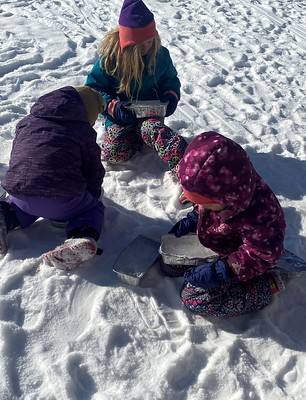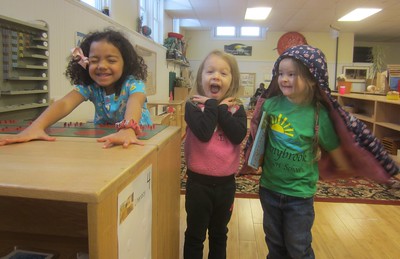Monday students had a remote day during which they did mitten activities for art, math, and literacy after reading The Mitten by Jan Brett.
Animals adapt to the changes of winter in different ways. Susan introduced some fun games and activities where we pretended to be different animals adapting to winter. We learned that many animals, such as snakes and groundhogs will huddle all together in a den or other safe place to keep warm. Penguins will huddle on the icy tundra to share body heat and block the wind. Geese will migrate south to warmer climates where food is easier to find. Foxes will listen under the snow for mice and voles, then herd and pounce to capture them. Susan would call out the name of an animal and the children would fly south, huddle, den up together, or hunt and pounce.
When animals are in their dens, the dens will trap their body heat and block cold winds, helping to keep the animals warm while the temperatures drop. We used blankets to create dens and huddle up together to protect us from the “cold” while pretending to be snakes and groundhogs.
We collected sleds full of snow and dumped them on our little snow pile to build up our sledding hill so we could finally do a bit of sledding. What excitement there was over our little hill when it was finally ready!
Work on the igloo continued. Removing the blocks from the tins, adding layers with water to freeze them together, packing on snow to fill in the cracks, placing out the pans, and refilling them with water to freeze more blocks kept everyone busy.
During sign language with Rose we practiced the ABC’s and all the animal signs we have learned over the past few weeks. Rose introduced 5 new animal signs for animals that live in the jungle, as well as the sign for jungle. We learned elephant, lion, tiger, monkey, and giraffe. Elephant is made by running the hand and arm out from the nose in the form of a trunk. Lion is shown by pulling the hand over the head from the forehead back to show the mane. Tiger is made by showing the stripes on the face using the fingers crooked toward the face and pulling back toward to ears. I bet you can guess monkey and have probably made this sign many times! Giraffe is the hand cupped at the neck and moving down to show a long neck. We then learned the signs for the song “One Elephant Went Out to Play on a Spider’s Web One Day,” including the sign for spider, made by tucking in the thumbs, crossing the hands at the wrists, and walking the fingers forward like spider legs.
During Spanish we practiced all our songs about the body, emotions, and colors. Zeanny introduced a song with the spanish words for all the family members and then read the story Mortimer by Robert Munsch. We then got to pick a colored egg shaker and moved it as directed, shaking lento, rapido, abajo, arriba, and adelante.
Kindergarteners worked on making sums of six with Cuisinarie rods. They finally got a chance to catch up on recording the days on the fence pickets, so they added days 75-85, then used the igloo ice blocks to make sets of ten. They made predictions about whether there would be enough blocks to make more sets of ten, then counted out and organized them into groups.
We celebrated another 5th birthday. The birthday girl very excitedly shared that she would have a unicorn cake at home with her family on her birthday and told us the season, month, and day that she was born. She walked carefully around the sun while we listed the seasons and counted for her. Happy Birthday 5 year old!
Friday students delved into rocks and how they form. This week we learned about igneous rocks – rocks that are formed by cooling magma or lava. Lava that erupts from a volcano and cools and solidifies outside the earth is called extrusive (ex-out of) rock, such as pumice and obsidian. Magma that cools slowly inside the earth crystalizes into rocks such as granite and are called intrusive rocks. We learned that The Granite State is the nickname for New Hampshire because we have so much granite! (We also learned that Lyn’s nickname in college was shortened from Lynny Poo to Poopy, which the children found hilarious. We will remind them that we do not call other people that). We watched a brief video about igneous rocks forming and then some short videos of volcanoes and flowing lava. We checked out some rocks, then did a little experiment by melting crayons down to see some “lava” type liquid, which became solid heart crayons for those who chose to make one to take home.
































































































